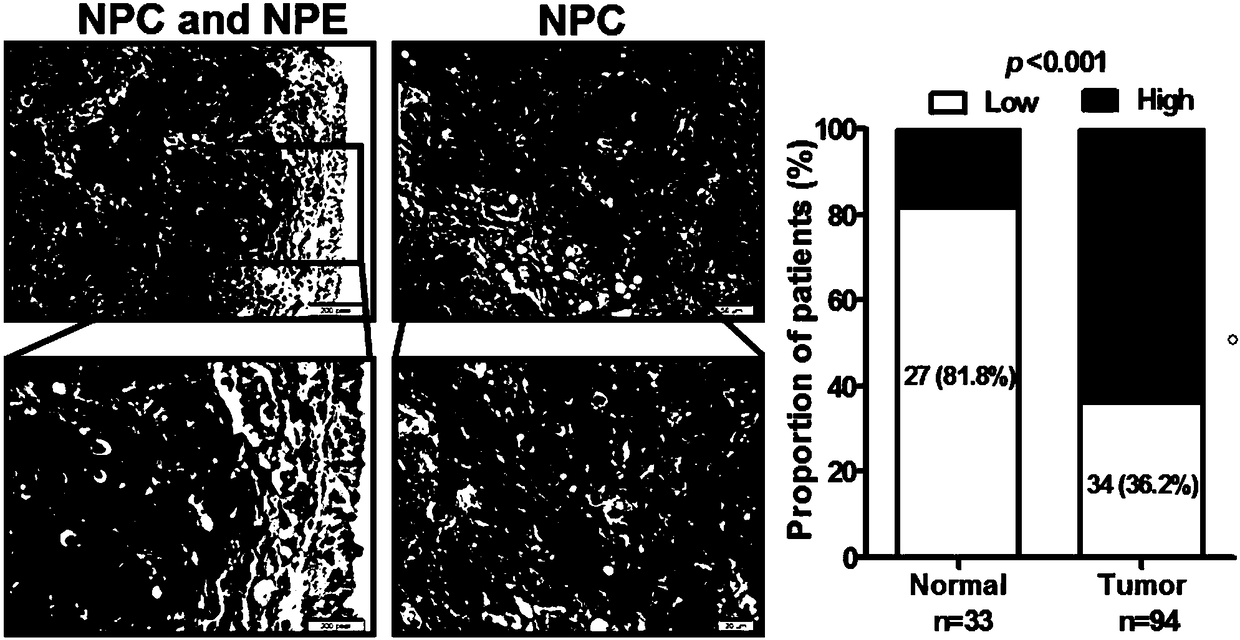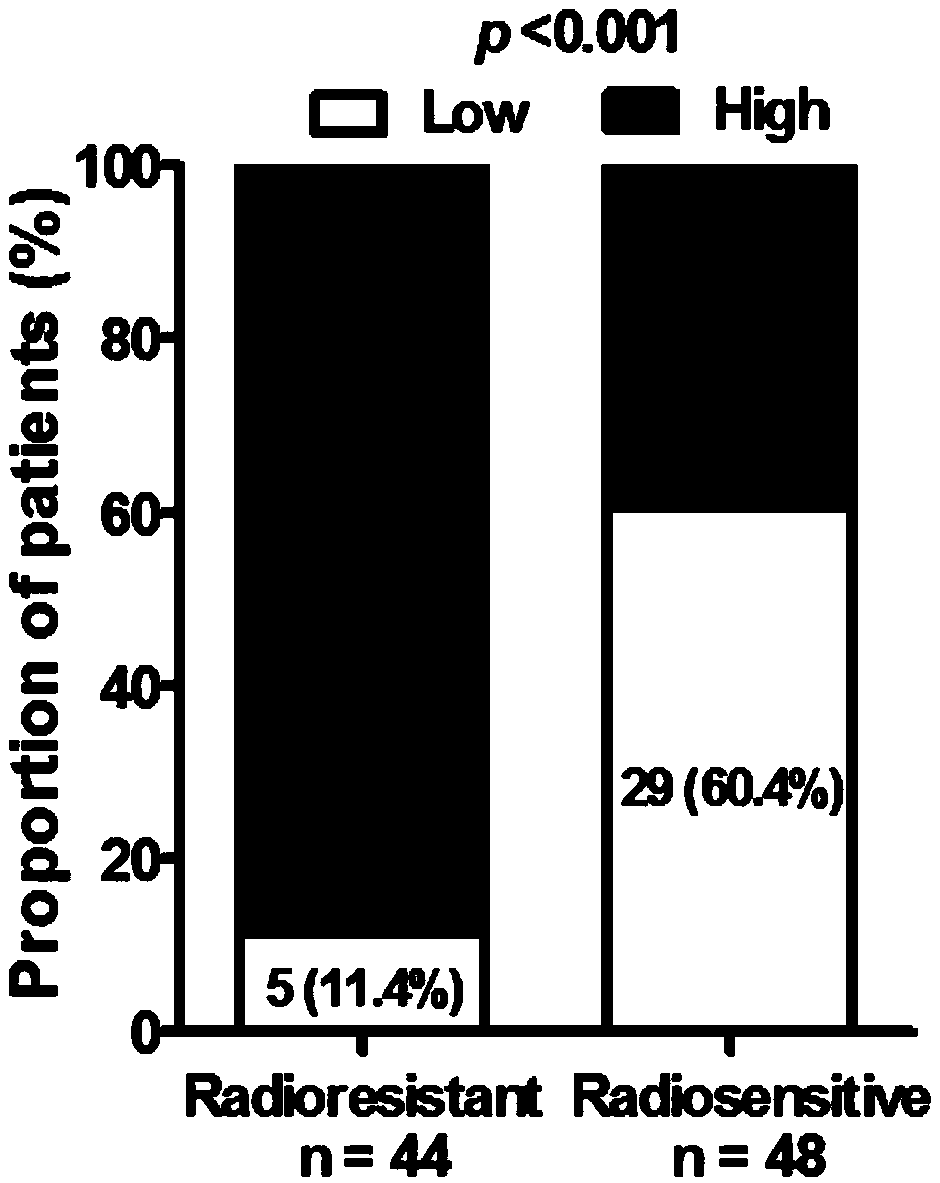Application of reagent expressed by interference long chain RNA PVT1 in preparing preparation for adjuvant therapy of nasopharyngeal carcinoma
A long-chain non-coding and adjuvant therapy technology is used in the preparation of nasopharyngeal carcinoma adjuvant therapy preparations and the field of reagents that interfere with the expression of long-chain non-coding RNA PVT1, which can solve the problems that radiation cannot completely kill tumor cells, patient death, and poor prognosis. , to achieve a clinically significant effect
- Summary
- Abstract
- Description
- Claims
- Application Information
AI Technical Summary
Problems solved by technology
Method used
Image
Examples
Embodiment 1
[0060] Example 1, real-time fluorescent quantitative PCR method detection confirmed that PVT1 was up-regulated in nasopharyngeal carcinoma
[0061] 1. Materials and methods:
[0062] 32 cases of normal nasopharyngeal epithelial tissues and 61 cases of nasopharyngeal carcinoma tissues were collected, total RNA was extracted, 2 μg RNA was reverse transcribed into cDNA, and real-time fluorescent quantitative PCR was performed. PVT1 forward primer is 5'-TGG CTG AGA GGG TTG AGA TC-3' as shown in SEQ NO:2, and reverse primer 5'-GCT GTA TGT GCC AAG GTC AC-3' as shown in SEQ NO:3 .
[0063] The GAPDH forward primer used for the control is 5'-ACCACAGTCCATGCCATCAC-3' as shown in SEQ NO:4, and the reverse primer 5'-TCCACCACCCTGTTGCTGTA-3' as shown in SEQ NO:5.
[0064] Real-time fluorescence quantitative PCR reaction system
[0065]
[0066] Real-time fluorescence quantitative PCR reaction steps
[0067]
[0068]
[0069] After the reaction, the amplification curve and melti...
Embodiment 2
[0072] Example 2, In situ hybridization detection found the expression of PVT1 in nasopharyngeal carcinoma, and its correlation with patient prognosis and radiotherapy sensitivity
[0073] 1. Material method
[0074] 1.1 Design and synthesis of hybridization probes
[0075] In order to detect the expression of PVT1 by in situ hybridization, we designed two groups of oligonucleotide probes for detection of PVT1 expression by in situ hybridization and three positive control in situ hybridization oligonucleotide probes.
[0076] Oligonucleotide probes for detection of PVT1 expression by in situ hybridization:
[0077] PVT1 probe 1: 5'-GGTCGGACTAGAAAACCGGTCTTCCTCTAATTTT-3' as shown in SEQ NO:6,
[0078] PVT1 probe 2: 5'-GAGACTGTAAAAACTTCTCAGGTCTTAGGA-3' as shown in SEQ NO:7,
[0079] PVT1 probe 3: 5'-CTCATAAAACTCTAACCTCTTAATTCTCGGTCAG-3' is shown in SEQ NO:8.
[0080] Positive control probe (to detect the housekeeping gene GAPDH):
[0081] GAPDH probe 1: 5'-CCACTTTACCAGAGTTAA...
Embodiment 3
[0145] Example 3, construction of shRNA vectors to interfere with the expression of PVT1
[0146] 1. Material method
[0147] 1.1 Reagents and kits
[0148] Restriction enzymes Hind III, Bgl II, EcoR I and Cla I, T4 DNA ligase, etc. were purchased from TakaRa;
[0149] TRIZOL TM Reagent (Invitrogen);
[0150] Plasmid Extraction Kit (#D6943-01, OMEGA);
[0151] Gel recovery kit (#M5212, OMEGA);
[0152] Reverse transcription kit (#A3500, Promega);
[0153] Antibiotic G418 (Ameresc).
[0154] 1.2 Design of shRNA
[0155] First, input the PVT1 sequence into Invitrogen's Block-It RNAi designer software to find the best shRNA target of the lncRNA, and select the best 3 corresponding target sequences as follows:
[0156] shRNA-1: GGACTTGAGAACTGTCCTTA as shown in SEQ NO: 12,
[0157] shRNA-2: GCTTCTCCTGTTGCTGCTAGT as shown in SEQ NO: 13,
[0158] shRNA-3: GCTCCACCCAGAAGCAATTCA shown in SEQ NO: 14,
[0159] The widely used Scramble sequence without any target in the human ...
PUM
| Property | Measurement | Unit |
|---|---|---|
| particle diameter | aaaaa | aaaaa |
Abstract
Description
Claims
Application Information
 Login to View More
Login to View More - R&D Engineer
- R&D Manager
- IP Professional
- Industry Leading Data Capabilities
- Powerful AI technology
- Patent DNA Extraction
Browse by: Latest US Patents, China's latest patents, Technical Efficacy Thesaurus, Application Domain, Technology Topic, Popular Technical Reports.
© 2024 PatSnap. All rights reserved.Legal|Privacy policy|Modern Slavery Act Transparency Statement|Sitemap|About US| Contact US: help@patsnap.com










